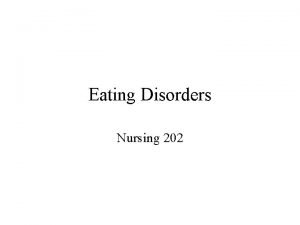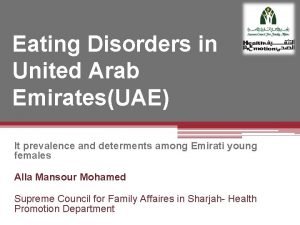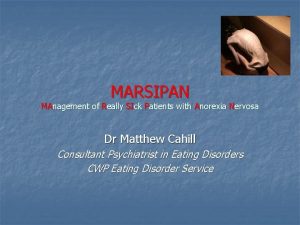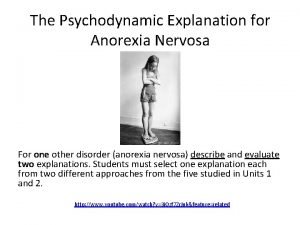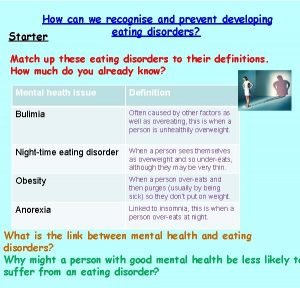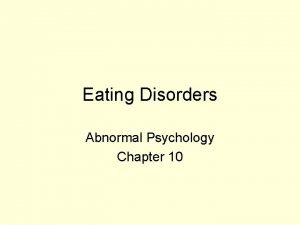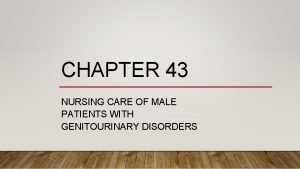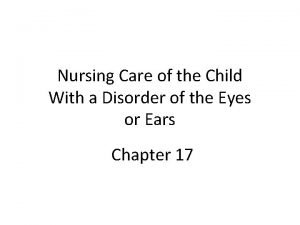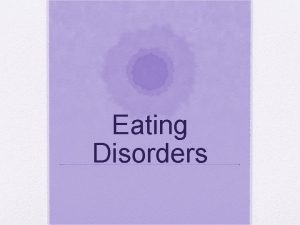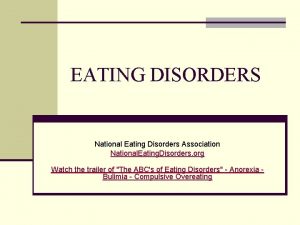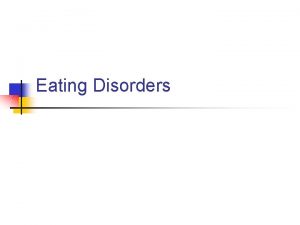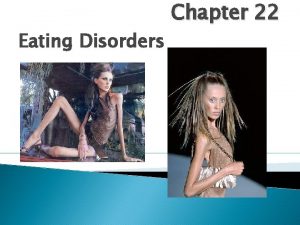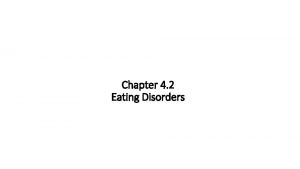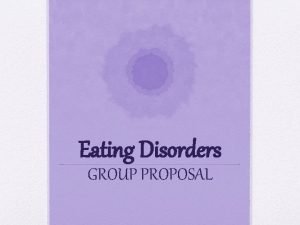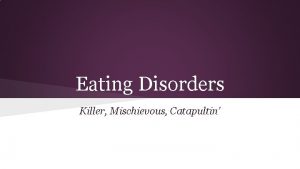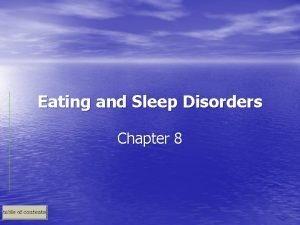Eating Disorders Nursing 202 Introduction The hypothalamus contains













- Slides: 13

Eating Disorders Nursing 202

Introduction • The hypothalamus contains the appetite regulation center within the brain. • It regulates the body’s ability to recognize when it is hungry, when it is not hungry, and when it has been sated. • Eating behaviors are influenced by – Society Culture • Historically, society and culture also have influenced what is considered desirable in the female body.

Anorexia nervosa • Prevalence rate of anorexia nervosa among young women in the United States is approximately 0. 5 to 1 percent. Occurs predominantly in females age 12 to 30 years. • Assessment • Predisposing Factors • Nursing Diagnosis • Planning and Implementation • Outcome • Treatment Modalities

Bulimia Nervosa • is more prevalent than anorexia nervosa. – Estimates range from 1 to 3 percent of young women. – Onset of bulimia nervosa occurs in late adolescence or early adulthood. – Occurs primarily in societies that emphasize thinness *Excessive vomiting and laxative or diuretic abuse may lead to problems with dehydration and electrolyte imbalances

Bulimia Nervosa • • • Assessment Predisposing Factors Nursing Diagnosis Planning and Implementation Outcome Treatment Modalities

Obesity • Obesity has been defined as a body mass index of 30 or greater. – Approximately 65% of adults are overweight, with 31 percent of these in the obese range.

• • • Assessment Predisposing Factors Nursing Diagnosis Planning and Implementation Outcome Treatment Modalities

Treatment Modalities • Behavior Modification – Issues of control are central to the etiology of these disorders. – For the program to be successful, the client must perceive that he or she is in control of the treatment. – Successes have been observed when the client • Is allowed to contract for privileges based on weight gain • Has input into the care plan • Clearly sees what the treatment choices are

Treatment Modalities – The client has control over • Eating • Amount of exercise pursued • Whether to induce vomiting – Staff and client agree about • Goals • System of rewards – The client has a choice whether to • Abide by the contract • Gain weight • Earn the desired privilege

Treatment Modalities • Individual Therapy • Family Therapy • Psychopharmacology

Psychopharmacology • Medications that have been tried with some success: – For anorexia nervosa: • Fluoxetine (Prozac) • Clomipramine (Anafranil) • Cyproheptadine (Periactin) • Chlorpromazine (Thorazine) • Olanzapine (Zyprexa) – For bulimia nervosa: • Fluoxetine (Prozac) • Imipramine (Tofranil) • Desipramine (Norpramine) • Amitriptyline (Elavil) • Nortriptyline (Aventyl) • Phenelzine (Nardil)

Psychopharmacology – For binge-eating disorder with obesity: • Topiramate (Topamax) -For obesity: • Fluoxetine (Prozac) • Sibutramine (Meridia) • Various anorexiants (CNS stimulants)

• Questions
 Eating disorder nursing diagnosis
Eating disorder nursing diagnosis Yorkshire centre for eating disorders
Yorkshire centre for eating disorders Eating disorders in uae
Eating disorders in uae Sarah fogarty
Sarah fogarty Chimps eating termites
Chimps eating termites Chapter 18 eating and feeding disorders
Chapter 18 eating and feeding disorders Marsipan eating disorders
Marsipan eating disorders Psychodynamic approach to eating disorders
Psychodynamic approach to eating disorders How to be anorexic
How to be anorexic How to spot eating disorders
How to spot eating disorders Kate moss eating disorder
Kate moss eating disorder Managing weight and eating behaviors
Managing weight and eating behaviors Nursing care of male patients with genitourinary disorders
Nursing care of male patients with genitourinary disorders Nursing care plan for conjunctivitis slideshare
Nursing care plan for conjunctivitis slideshare
